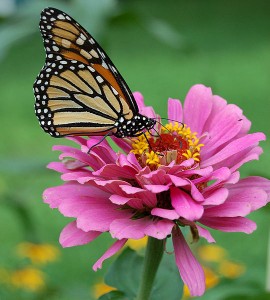No, not the Old Dominion University sports teams. We’re talking about the monarch butterfly, a pollinator that is in trouble and needs our help.
The monarch is native to North America and has a remarkable life cycle. Like most butterflies, the monarch has several short-lived generations during its breeding season in the U.S. and Canada. What is unique about the monarch is that the final generation of late summer begins a long distance migration of up to 3,000 miles to a single region in central Mexico. There, the monarchs overwinter on a specific type of fir tree in large colonies. How the butterflies find this area of Mexico where they have never been is a mystery. The following spring, these monarchs begin their trip back north, laying eggs along the way. To make such long trips down and back, the butterflies need nourishment from the nectar of a wide variety of flowers.
 Monarchs are also unique because they lay their eggs only on milkweed plants. Monarch caterpillars have evolved to eat the milkweed to get that plant’s toxic compounds, which help keep other insects and birds from eating them.
Monarchs are also unique because they lay their eggs only on milkweed plants. Monarch caterpillars have evolved to eat the milkweed to get that plant’s toxic compounds, which help keep other insects and birds from eating them.
Monarchs are in trouble, primarily due to the loss of milkweed and nectar plants in the U.S. and Canada and threats to their forested wintering habitat in Mexico. As recently as 1996, there were some 1 billion monarchs, but their numbers have declined by about 90 percent. The decline is so drastic that Mexico, the U.S. and Canada established a working group to save the monarch.
Believe it or not, our area is on the migration route for eastern monarchs heading to Mexico in the late summer and fall. And of course, we are used to seeing the bright orange and black butterflies throughout the summer. So we really can do things that will help not only monarchs, but other pollinators as well. Here’s how you can help these amazing North American butterflies!
- Plant Milkweeds – There are over 100 species of milkweed (Asclepias) in North America. Several species are native to Virginia, including orange butterfly weed and common milkweed, often seen along roadsides. If you plant tropical milkweed (which is not native here), cut it back in October to encourage the monarchs to keep flying south as the temperatures drop. Be aware that milkweeds take up a lot of room in the garden and the native species spread by underground roots.
- Cultivate Nectar Plants – These are some plants that adult monarchs like: azaleas, purple coneflower, black-eyed susan, coreopsis, verbenas, lantanas, cosmos, marigolds, impatiens, zinnias, and pentas.
- Avoid Pesticides – Pesticides kill all insects, good and bad.
- Learn More – A good source of information about monarchs and their threats is the website Monarch Joint Venture. There you will find information on growing milkweed native to our area and where to get seeds and plants. The Norfolk Botanical Garden and the Butterfly Society of Virginia will host a Butterfly Festival on July 11, with demonstrations, fun activities for the kids, and experts to teach how to attract butterflies to your yard.
Blog post contributed by Karen Mayne. Karen is a biologist retired from the U.S. Fish and Wildlife Service who resides in Norfolk and enjoys writing about environmental issues.